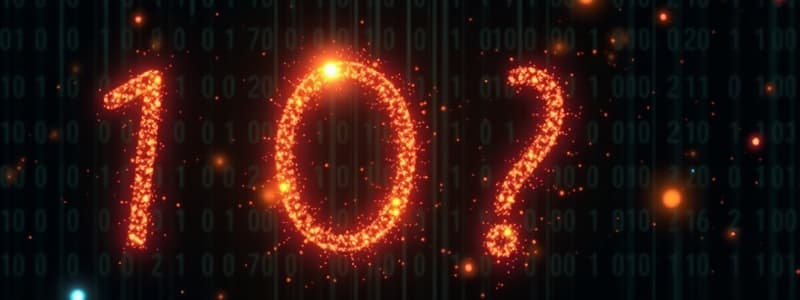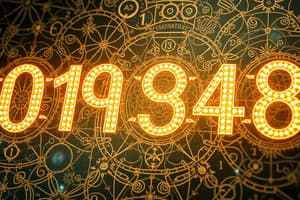Podcast
Questions and Answers
What is the base of the binary number system?
What is the base of the binary number system?
- Base 8
- Base 10
- Base 2 (correct)
- Base 16
Which digit in a binary number represents the on state?
Which digit in a binary number represents the on state?
- 2
- 1 (correct)
- 0
- Both 0 and 1
What algorithm can be used to convert a decimal number to binary?
What algorithm can be used to convert a decimal number to binary?
- Subtraction Algorithm
- Multiplication Algorithm
- Division Algorithm (correct)
- Addition Algorithm
In the binary number 11101101, which digit is the least significant?
In the binary number 11101101, which digit is the least significant?
What remainder sequence is obtained when converting the decimal number 67 to binary using the Division Algorithm?
What remainder sequence is obtained when converting the decimal number 67 to binary using the Division Algorithm?
What is the base of the decimal number system?
What is the base of the decimal number system?
In the decimal system, what is the value of the digit 7 in the number 572?
In the decimal system, what is the value of the digit 7 in the number 572?
If a number is expressed in base 10, how would the number 15 be represented in base 2?
If a number is expressed in base 10, how would the number 15 be represented in base 2?
Which statement about the decimal system is true?
Which statement about the decimal system is true?
What is the decimal equivalent of the binary number (10101101)2?
What is the decimal equivalent of the binary number (10101101)2?
In the multiplication algorithm for binary to decimal conversion, how are the binary digits treated?
In the multiplication algorithm for binary to decimal conversion, how are the binary digits treated?
Which of the following steps is NOT part of the binary to decimal conversion via the multiplication algorithm?
Which of the following steps is NOT part of the binary to decimal conversion via the multiplication algorithm?
What do you do after multiplying the binary digits by their positional values in the multiplication algorithm?
What do you do after multiplying the binary digits by their positional values in the multiplication algorithm?
If a binary number has the digits 1 in positions 7, 5, and 1, what would be the decimal contribution of these positions?
If a binary number has the digits 1 in positions 7, 5, and 1, what would be the decimal contribution of these positions?
Flashcards
Decimal System
Decimal System
A numbering system with ten unique digits (0-9) where each digit's position represents a power of ten.
Numbering System
Numbering System
A system for representing numbers using a fixed set of symbols, each representing a specific value.
Base of a Numbering System
Base of a Numbering System
The base of a numbering system determines the number of unique symbols used to represent values.
Positional Value
Positional Value
Signup and view all the flashcards
Number Base Conversion
Number Base Conversion
Signup and view all the flashcards
Binary Number System (Base 2)
Binary Number System (Base 2)
Signup and view all the flashcards
Division Algorithm
Division Algorithm
Signup and view all the flashcards
Most Significant Digit (MSD)
Most Significant Digit (MSD)
Signup and view all the flashcards
Least Significant Digit (LSD)
Least Significant Digit (LSD)
Signup and view all the flashcards
Decimal to Binary Conversion
Decimal to Binary Conversion
Signup and view all the flashcards
Multiplication Algorithm for Binary-Decimal Conversion
Multiplication Algorithm for Binary-Decimal Conversion
Signup and view all the flashcards
Positional Value in Binary
Positional Value in Binary
Signup and view all the flashcards
Base-2 Number System (Binary)
Base-2 Number System (Binary)
Signup and view all the flashcards
Decimal Equivalent Calculation from Binary
Decimal Equivalent Calculation from Binary
Signup and view all the flashcards
Base Conversion
Base Conversion
Signup and view all the flashcards




